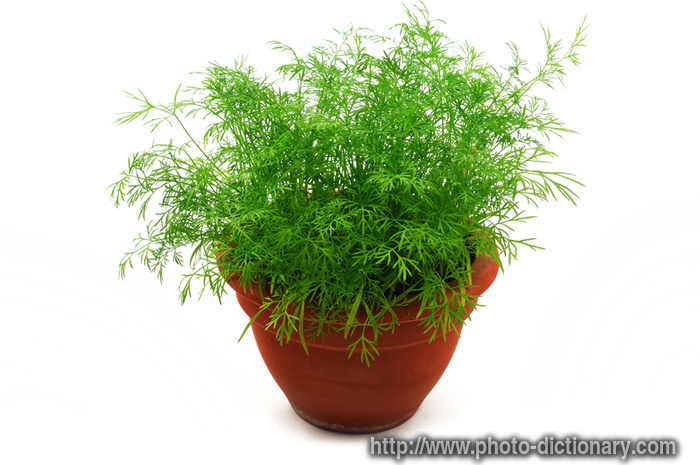
DILL
Dill grows two to three feet tall. It may be planted in spring or fall. Planted in early spring, dill will produce seeds during the same season. It can also be planted in fall so that the seed germinates on it's own when conditions are right.
Sown in drills 15 to 18 inches apart in early spring in warm soil and a sunny place. Thin the seedlings while small to stand 8 to 10 inches asunder. Cultivate frequently. In midsummer cut the ripening heads and spread thinly on sheets. When dry, thresh with light rods. Clean and store the seed in cotton sacks in dry quarters.
The leaves are thin, wispy and fern like. The plant yields two different herbs: dill seed (the fruit of the plant) and dill weed (the top eight inches of the leaves). Dill blooms and sets seeds when nights are short and days are warm. The delicate, feathery plants are blue green and grow from 3 to 5 feet tall. Dill requires to be fertilized in the early spring, this will ensure hearty growth throughout the summer.
The dill plants should be sheltered from winds. Although necessary for good pickles, there are many more ways dill can be used. Dill is tasty with eggs and poached fish, especially salmon. Add fresh dill to pasta or marinate chicken in plain yogurt and lots of fresh dill before grilling. Use fresh dill in potato salad, coleslaw, fresh beets, muffins and hollandaise sauce. Dill seed improves digestion and appetite and sweetens the breath. The oil kills bacteria and relieves flatulence."
Growing Dill
Growing Cultures
Outdoors, containers (sow directly in pots, do not transplant, 8 to 20 seeds per pot), hydroponics.
Plant Height
Dill grows to a height of 24 to 36 inches (60 - 90cm).
Plant Spacing
Dill plants should be spaced 12 to 15 inches (30 - 38cm) apart.
Preferred pH Range
Dill will grow in a relatively wide pH range between 5.5 (strongly acidic) and 7.5 (mildly alkaline) with a preferred range between 5.5 and 6.5.
Propagation
From seed. Direct sow outdoors in fall or in spring after last frost.
Seed Germination Period
7 to 10 days.
Seeds Per Gram (Approximate)
Between 400 and 1000.
Soil Requirements
Well-drained, moderately rich, loose soil.
Alternative Growing Media
soiless potting mixes, perlite, vermiculite, rock wool, coco peat, Oasis foam.
Time From Seed to Plant
Six weeks.
Sun & Lighting Requirements
Dill grown outdoors prefers full sun.
Dill grows well indoors under high output fluorescent plant lights and high intensity halide and sodium lamps.
USDA Hardiness
Annual. Not applicable.
Water Requirements
Water on a regular schedule, do not over water.
Potential Pests & Diseases
Aphids. Powdery mildew.
Special Notes
Dill is known to attract bees, butterflies or birds.
Dill leaves can be snipped and frozen in ziplock bags. Dill vinegar can be prepared by soaking a few leaves in vinegar for 4 or 5 days. Dill leaves are excellent when chopped and used in soups, salads, cottage cheese, roasted potatoes, and many other dishes. Dill is also used extensively in Europe to flavor cakes and other pastries.
Growing Cultures
Outdoors, containers (sow directly in pots, do not transplant, 8 to 20 seeds per pot), hydroponics.
Plant Height
Dill grows to a height of 24 to 36 inches (60 - 90cm).
Plant Spacing
Dill plants should be spaced 12 to 15 inches (30 - 38cm) apart.
Preferred pH Range
Dill will grow in a relatively wide pH range between 5.5 (strongly acidic) and 7.5 (mildly alkaline) with a preferred range between 5.5 and 6.5.
Propagation
From seed. Direct sow outdoors in fall or in spring after last frost.
Seed Germination Period
7 to 10 days.
Seeds Per Gram (Approximate)
Between 400 and 1000.
Soil Requirements
Well-drained, moderately rich, loose soil.
Alternative Growing Media
soiless potting mixes, perlite, vermiculite, rock wool, coco peat, Oasis foam.
Time From Seed to Plant
Six weeks.
Sun & Lighting Requirements
Dill grown outdoors prefers full sun.
Dill grows well indoors under high output fluorescent plant lights and high intensity halide and sodium lamps.
USDA Hardiness
Annual. Not applicable.
Water Requirements
Water on a regular schedule, do not over water.
Potential Pests & Diseases
Aphids. Powdery mildew.
Special Notes
Dill is known to attract bees, butterflies or birds.
GROWING DILL
HARVESTING DILL SEEDS
FRESH DILL READY FOR DE HYDRATING




No comments:
Post a Comment